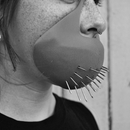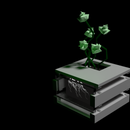Introduction: Project5_generative_design
This week's assignment was to generate a chair (or anything else) using topology optimization or generative design functions in Fusion 360.
I investigated generative design the most. It felt weird to leave my design, which was generally composed of very simple parts, overnight and to find its finale evolutions the next morning. It felt removed from the act of designing somehow. It was fun though to see these newborn creatures!
I made a little animation in Unity to visualize my most successful designs behaving or interacting with other beings in space. I also printed some of them at a smaller scale, which I found less successful, mainly because it required a lot of work to remove the support structures.
Supplies
Fusion 360
Ender 3 Pro
Filament
Step 1: Bench - Design Process
I began to draw on paper simple profiles of somethings that could be a bench or a nightstand. I chose the profile that felt the most interesting and modeled it in Fusion 360. I wanted to experiment with the generative design function, so I needed to remove some part of the drawn profile in order to have the software completes it using its secret algorithm. I kept only the sitting part, the two feet and the offset elevated section. I placed some obstacles for the algorithm to avoid (in red in the last picture) in order for my design to retain its original profile. I was imagining that the triangular section could hold newspaper or magazines.
The final outcome was satisfactory! It remained true to the desired profile while introducing interesting organic features.
Step 2: Bench - Printing Process
I printed the previous design. The print seemed great but I realized that the support structure was extremely hard to remove. I should have decreased its density. Therefore, I struggled quite a bit to extract the part and ended up breaking all of the delicate parts of the print. I also printed the bench downward, so the sitting region texture got really rough.. it could have been better.
Step 3: Bimaterial Table - Design Process
The next thing I wanted to try was to make a tea table that would embrace the organic qualities of generative design and that would integrate my two filament colors (grey and transparent). I separated the tabletop from the base and applied the generative design algorithm on the base only. I made sure to define the tabletop and a portion between the legs as obstacles.
The final outcomes were very extreme and aesthetically terrible. But I realized that some intermediary outcome were interesting. One of them looked like a cave or the roots of a tree, which felt like the desired aesthetic for a tea table.
Step 4: Bimaterial Table - Printing Process
I printed my table top out of a transparent filament and used the gyroid infill, which I thought would go well with the whole design.
And I printed the base with the grey filament. Like the previous print, the support structure was hard to remove, but since the part was not as delicate the procedure went well. It became even a little therapeutic. However, The final print is still rough and would require some sanding.
Also the surface of the base that support the tabletop should have been wider. Currently, the tabletop falls down if not reinforced with duck tape (carefully located so it doesn't show in the photos!).
Step 5: Rocking Chair
I finally tried to make a rocking chair through generative design. It didn't return very interesting results. And again the outcome that I found the most exciting was an intermediary design that looked a little bit like the skull of an alien creature. Here it is --^











